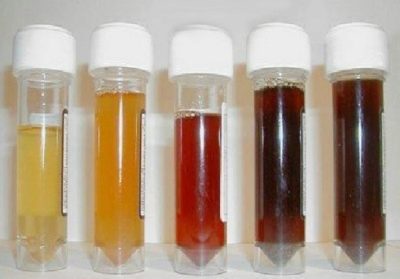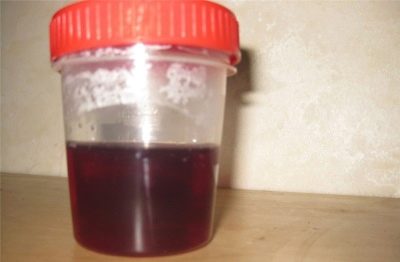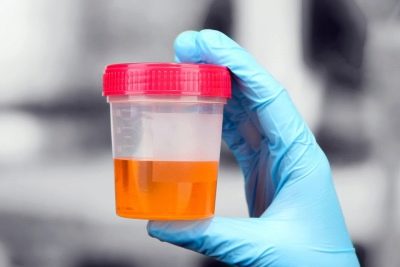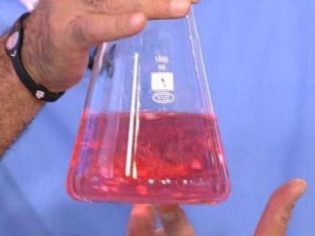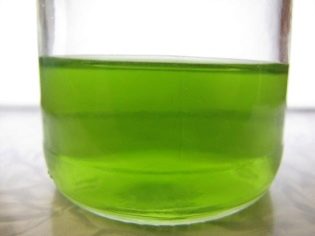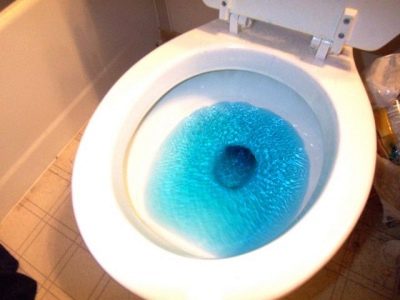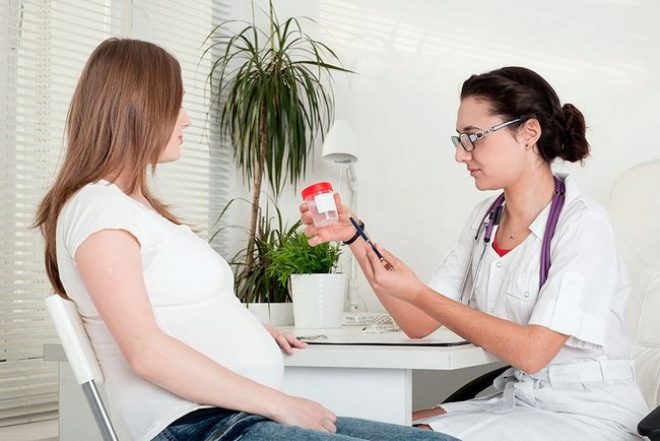What does urine color indicate during pregnancy, and how should it be normal?
Pregnant women pay special attention to urine color. In the people it is believed that according to this feature it is possible to determine the sex of the child in the early stages. Is this how it should be and the color of the fluid excreted by the kidneys from expectant mothers, we will tell in this article.
Why does urine change color?
The color of urine with the onset of "interesting" position changes. And there are many reasons for this.
The body of a pregnant woman undergoes a large-scale "adjustment", all the organs and systems of the woman begin to work in a different mode. Many of them are switching to the "economy" mode in order to save as much energy and nutrients as possible for the baby growing under the heart of a woman.
The hormonal background changes, the composition of the urine itself becomes somewhat different, metabolic processes in the body proceed differently. All this can not affect the shade of urine.
Since the analysis of the excreted fluid is the most frequent, it is done before each visit to the doctor, women pay attention to the fact that the color of the fluid is extremely unstable - every time it is different.
Many things affect urine color:
- The presence of toxicosis. Nausea, lack of appetite lead to moderate dehydration. Because of this, the urine becomes more concentrated, bright.
- Drinking mode. If the pregnancy falls on the hot summer months, when fluid loss from the sweat is higher, if the woman drinks little water, the urine again becomes more concentrated. And if a woman drinks a lot, the color of the secreted fluid becomes less saturated.
- Some medicines. Many drugs can change the color of urine - antihistamines, calcium supplements, vitamins. Folic acid, recommended to all future mothers, by the way, also makes the color of urine more vivid.
- Food. If a woman in an "interesting" position is addicted to beets, carrots, pomegranates, garlic, then the change in urine color is a completely natural consequence of eating these products. Beets, for example, make the urine red, and the carrot - bright orange.
- Metabolism baby. Metabolism products of the child are excreted through the umbilical cord and the placenta into the maternal blood, and from there into the urine. Therefore, the color of urine during pregnancy and changes.
- Gestosis. In the second and third trimester, a change in the color of fluid excreted by the kidneys may be an indirect sign of preeclampsia. If the new shade of urine is accompanied by edema, instability of blood pressure, the woman needs qualified medical assistance.
- Hypertension. Increased pressure also changes the shade of the excreted fluid. In this case, it is necessary to find the cause of the increase in pressure, the correction of this indicator will help to normalize the color and shade.
- Diseases of the kidneys, ureters, urethra. Any deviations in the functioning of the urinary system necessarily affect the color of urine. The hue of the urine in this case depends on the specific disease. In some pathologies, blood appears in the urine, in others - sediment, pus.
Color depends on a whole set of different factors:
- woman's metabolism - the rate of flow of metabolic processes in her body;
- the presence of viral or other infectious diseases;
- normal functioning of the liver, gallbladder;
- possible blood disorders.
Norms
The color of urine is determined during the general analysis. This indicator diagnosticians pay special attention. To assess the color there is a special color scale, reminiscent of the graphic designer's palette. Color depends on transparency, consistency of solutes and color intensity.
The color of urine is given by special pigments - urochrome, uroerythrin, urosein, stercobilin. All these pigments in different quantities give a wide range of yellow shades.
In order to properly assess the shade of the excreted fluid, it is important to provide the morning portion of urine to the laboratory, because it is considered the most concentrated. In addition, it should be delivered as quickly as possible - no later than 2 hours after collection. Otherwise, test results will not be reliable.
In a liquid that has been in a jar for more than 2 hours, fermentation and decomposition of solutes begin, break down into small fragments and urine-dyeing pigments, which distorts the color and prevents the laboratory assistant from obtaining truthful and informative research results.
The concept of "norm" in relation to the color of urine is a rather vague concept. Norm each person has his own. To say whether his color is normal, you need to consider what kind of lifestyle he leads, what he eats, what medicines he takes.
Generally speaking, for pregnant women normal liquid urine is considered to be a light yellow liquid — straw. A more saturated yellow is also a variant of the norm. Sometimes reddish and pink urine will be normal. But the dirty brown, greenish, muddy shades, urine with white flakes in the range of norms does not fit.
What does urine color mean?
When changing the shade of urine, a woman is always interested in what reasons could be the reason for this. The most accurate answer can be given by laboratory diagnostics, which allows us to evaluate not only the color and transparency, but also the main quantitative indicators, the content of salts and other substances. We will tell about the most frequent variants of the color of the emitted liquid.
Red
Red or burgundy liquid in the norm can only be after eating borscht, beet salad, dishes with red food dyes. If there was no such food in the future mom's ration on the eve of the collection, the red color is a very disturbing sign indicating about the presence of blood in the urine.
Erythrocytes in the excreted fluid may appear due to mechanical trauma of the urinary tract, for example, "sand" or "stone" in urolithiasis, which is quite common among pregnant women.
Red urine can talk about the development of a tumor in the body, inflammation and injuries of the kidneys, ureters, urethra, genital organs.
In pregnant women, urine reddens most often due to oxolates, which, being compressed into stones, have sharp jagged edges, when they pass through the urinary tract, they injure mucous membranes, and a large number of red blood cells get into urine.
The condition may be accompanied by renal colic, and may be completely asymptomatic, when, apart from red urine, there will be no other signs of disturbance. Sometimes the blood in the urine forms clots that interfere with the patency of the ureters. Symptoms of delayed urination appear, after a delay the liquid turns red.
Red blood cells in the urine give it a different intensity of red shades. If the urine has a reddish-brown, dirty color, then it is most likely the presence of myoglobin in the excreted fluid. This may indicate a trauma to the muscular tissues of the urinary system, the consequences of the syndrome of prolonged compression of its individual parts.
Red urine is a reason to visit a nephrologist. Most often with the appearance of such a symptom associated diseases such as glomerulonephritis, cystitis, urolithiasis, pyelonephritis.
It is important to evaluate and additional symptoms - swelling, pain during urination, pain at the beginning and at the end of urination, fever, pain in the lumbar region, lower abdomen.
Even if the temperature is normal and the pain is absent, the appearance of red blood cells in the fluid secreted by the kidneys requires an obligatory diagnosis aimed at establishing the true cause.
Orange
Two types of pigments, urochrome and urobilinogen, give a rich orange color to the secreted fluid. In large quantities from the blood, they stand out when a woman adds to her diet carrots and carrot juice, oranges, and canned food with a sufficiently high content of various preservatives.
If there was no such food in the ration before, the bright color can be related with dehydration of the body. Some women, in order to avoid swelling and excessive weight gain, are “preparing” for the next doctor's appointment with fasting days and a decrease in the amount of fluid consumed.
As a result of a small amount of drinking, especially in summer, dehydration occurs, urine becomes bright orange due to an increase in the proportion of substances dissolved in it.
With the phenomenon of orange urine, expectant mothers who love to visit baths and saunas. Some even in the period of carrying a child can not part with this habit. Increased sweating also reduces the amount of urine and makes it concentrated.
Orange becomes urine when taking multivitamins, especially with an increased content of vitamins of group B. At the beginning of pregnancy, bright yellow and orange urine accompanies folic acid intake, which is recommended to drink to all expectant mothers in the first trimester to avoid fetal neural tube defects.
If the liver or gall bladder is impaired, urine may turn orange due to bilirubin in the blood. This pigment, which is formed during the breakdown of certain proteins, for example, hemoglobin, can be produced in large quantities and in some blood diseases.
The fluid with increased bilirubin has a rich amber color. If the jar with the material for laboratory diagnostics is shaken, a small amount of foam is formed, which also has a yellow color.
Colorless, white
Under colorless is usually understood urine, devoid of color in general or having a white color. Similar to milk, urine becomes when released into the excreted lymph fluid. This becomes possible due to some pathologies of the kidneys and bladder.
In the later stages of pregnancy, the lymph duct can be squeezed by a greatly enlarged uterus, which can also lead to lymph penetration into the urine.
White and non-uniform fluid can become an internal abscess of the kidney. This happens infrequently, but the condition is considered quite dangerous. A woman needs urgent medical attention.
Transparent, practically pigment-free urine can be observed in expectant mothers, who drank a lot of liquid on the eve of the collection of the analysis fluid. And this is probably the only physiological reason. The rest are signs of disease. Colorless urine becomes in diabetes mellitus, including in gestational diabetes of pregnant women, in renal failure.
Brown
Dark urine may indicate severe dehydration. Usually its color becomes normal after optimization of the drinking regime. Brown urine is observed in expectant mothers suffering from constipation and laxative teas struggling with them. That is why it is better to use rectal suppositories, they effectively relax the intestines, without having any effect on the shade of urine.
Brown urine becomes after ingestion of a large amount of garlic, after taking drugs with a high content of vitamins of group B.A large dose of ascorbic acid and iron supplements can also cause a change in shade to brown.
Among the pathological causes not the last place is given to such dangerous diseases as hepatitis B and C, gallstone disease, tumor processes in the liver, pancreatic disorders. Such fluid can accompany blood diseases associated with the rapid and rapid breakdown of red blood cells.
Dark shade is characteristic of women who have received toxic poisoning, for example, mercury vapor. Brown urine becomes future mothers with an infectious lesion of the urinary tract.
Pink
Pink secreted fluid, although it looks somewhat frightening, most often does not speak about something pathological. In most cases, the urine turns pink if the expectant mother on the eve ate cherry or blackberry, canned meats, drank lemonade or ate candy-lollipops with red food coloring.
Urine turns pink after consuming a drug like "Ibuprofen", as well as drugs that contain acetylsalicylic acid.
If the pink color changes to a normal yellow of any shade within a few hours, there is no cause for concern.
If there is a tendency to change the color of the urine to a brighter, reddish tint, you should pay attention to the state and functioning of the kidneys, bladder, ureters.
If a pregnant woman has her face, arms, legs in the morning, if she usually starts to go to the toilet for a little need more often, if her blood pressure rises, and the liquid itself acquires an unpleasant pungent odor should immediately do an ultrasound of the kidneys and bladder and with the results of this examination go to an appointment with a nephrologist.
Green and blue green
All shades of green are peculiar to impurities of pus. Typically, such processes do not go unnoticed; in addition to an abnormal hue fluid, a woman has all the signs of purulent inflammation of the urogenital system - high fever, severe pain, swelling. Blue-green liquid says about infection with a pyocyanic stick.
Blue
Heaven-colored urine is very rare, but it happens. In such an unusual color, some drugs may stain urine, for example, phenacetin, some vitamin complexes, as well as antibiotics - tetracyclines, if for some reason they are prescribed to a pregnant woman with diabetes.
Quite rarely there is such a metabolic disorder as excessive accumulation of tryptophan protein. If the expectant mother has such a pathology, then the accumulation of protein that stains urine in blue will be facilitated by eating turkey, chicken, fish and seafood.
Sex determination
The question that interests many pregnant women at the beginning of the term of gestation, when there is practically no other opportunity to find out the sex of the baby, whether the sex affects the color of the urine. In the forums of future mothers, these issues are often discussed. Popular rumor says that bright color is a sign of carrying a son, and pale, almost colorless urine may indicate that a girl is growing in the womb.
From the point of view of medicine, these statements have no meaning. There is no rational explanation in favor of such a diagnosis of sex, because, as we have already found out, the color of the fluid excreted by the kidneys is formed under the influence of very different factors.
But as a funny fortune telling, such a method is quite suitable, as well as determining the sex from the blood tables, from the Chinese table and the vibrations of the wedding ring on a string over the belly. Accuracy of diagnostics of sex in the color of urine is exactly 50%because there are only two options.
What to do when changing colors?
When changing the color of the urine should not panic. If the future mother's state of health is good, and there are no complaints, then it is possible to observe changes in the color gamut in the dynamics for 1-2 days.If everything stabilizes, there is no need to consult a doctor.
If the changes have become persistent and have nothing to do with nutrition, the amount of fluid consumed, the intake of medicines and vitamins, then consultation of the doctor for the pregnant woman is obligatory.
Delay with the appeal is not worth it. Many diseases, including infectious ones, may have a “blurred” or latent onset, and therefore it is important to quickly and accurately detect them and begin timely treatment. Before an unscheduled visit to the gynecologist, be sure to pass urine for analysis, following all the rules for collecting such an analysis.
Deviations from the norms will become apparent after the doctor receives the results of laboratory tests. You should definitely tell the doctor what you ate and drank the day before, what medications you have taken in the last few days. Ultrasound of the kidneys and bladder will complete the picture. Most of the diseases that cause changes in the shade of urine are successfully treated with timely detection even during pregnancy.
Some ailments disappear on their own, after a woman gives birth, because pregnancy itself is a good enough reason for urine to be surprised with various shades.
What does urine color say and how should it be normal? This and not only see in the next video.










